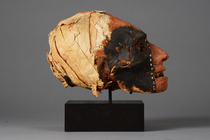Overmodeled ancestor skull, 19 th/ 20th century · Vanuatu, Malekula Island · ID: 3044624
Paul Harrison, Alaska, USA
Scott Rodolitz, New York, USA
Monika Edelmaier, Berlin, Germany
Description
human skull, wood, clay, pigments, pandanus fibre, base
Presumably part of a complete ancestor effigy, called “rambaramp”. These effigies were created only for men of the highest rank, usually chiefs or warriors. Once completed, the “rambaramp” would be set up in the men’s house.
By offering a place for the spirit to reside, the figure faciliated the continuing presence of the ancestor, who would, in turn, ensure the well-being of the community. Because they were made largely of vegetal materials, the bodies of the “rambaramp” would eventually decay. However, the skull - the most vital part of the figure - would continue to serve as a representative of the ancestor long after the body was gone.
The object Overmodeled ancestor skull, 19 th/ 20th century with the object ID 3044624 was part of the auction 90.I Tribal Art and 90.II Contemporary Native American Art on November 17, 2018. The object with the lot number 77 achieved a sales price of EUR 5,000 with an asking price of EUR 4,500.
Here you will find more objects and interesting facts about Oceanian art.
Comparing literature
Kaufmann, Christian, Vanuatu - Kunst aus der Südsee, Basel 1997, ill. 134 & 163





